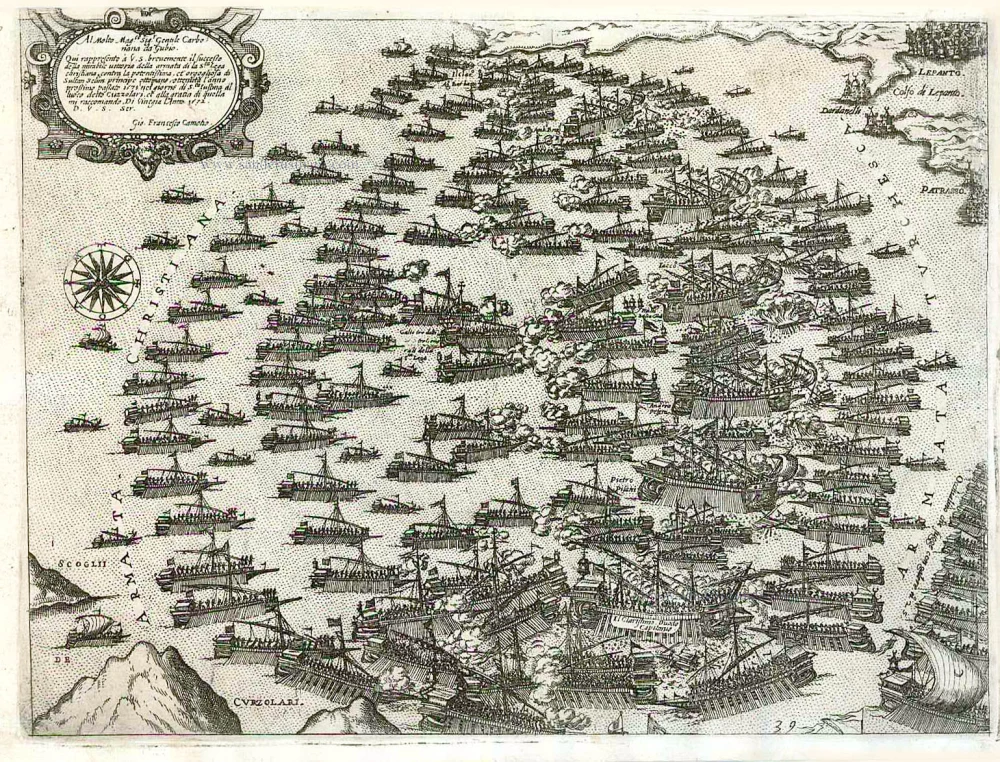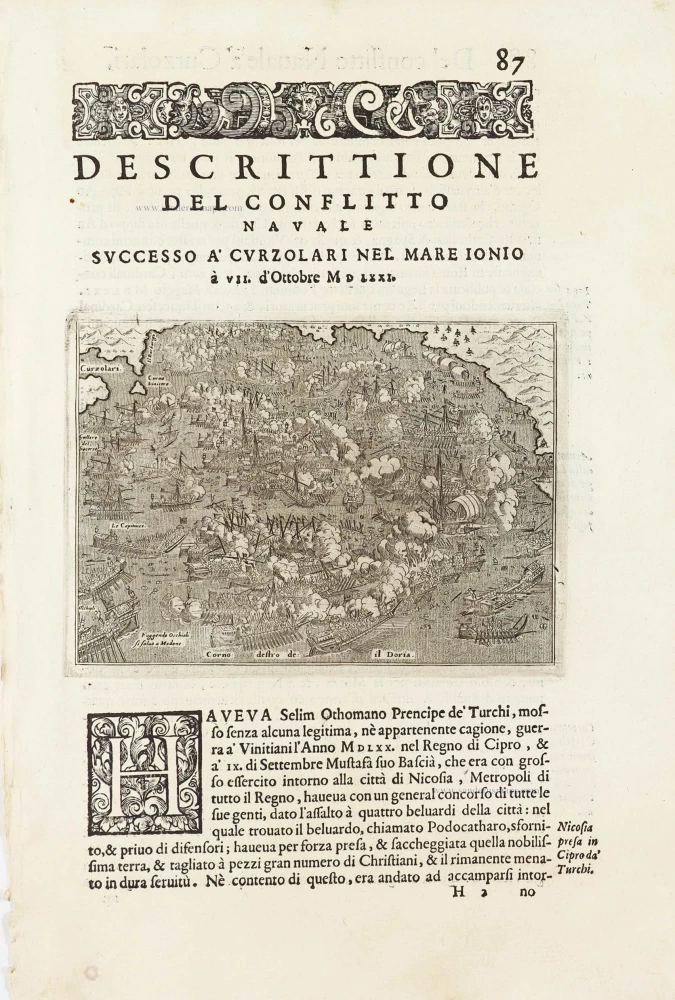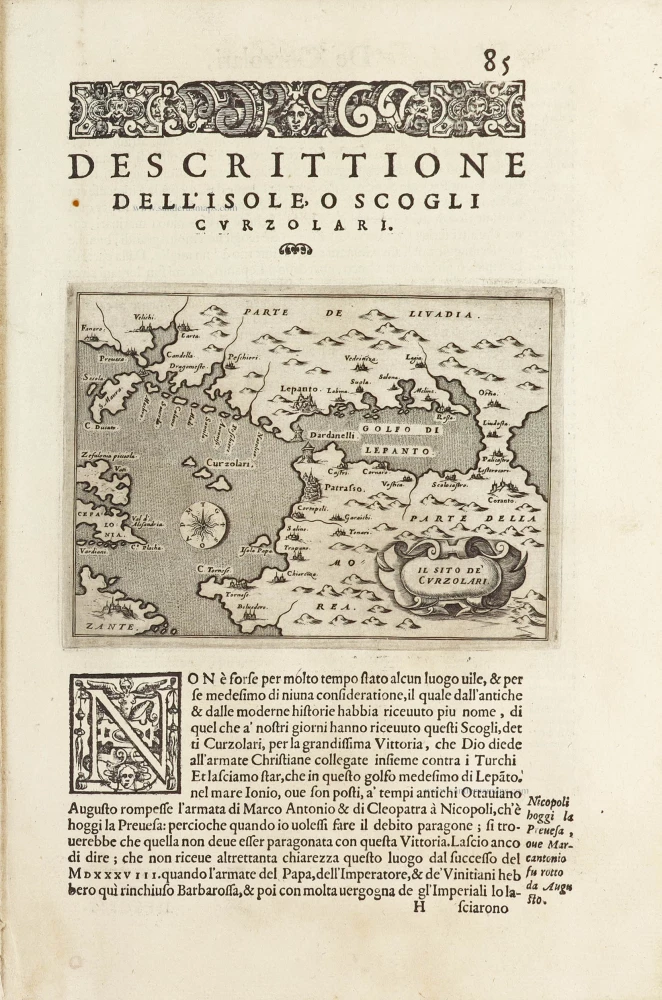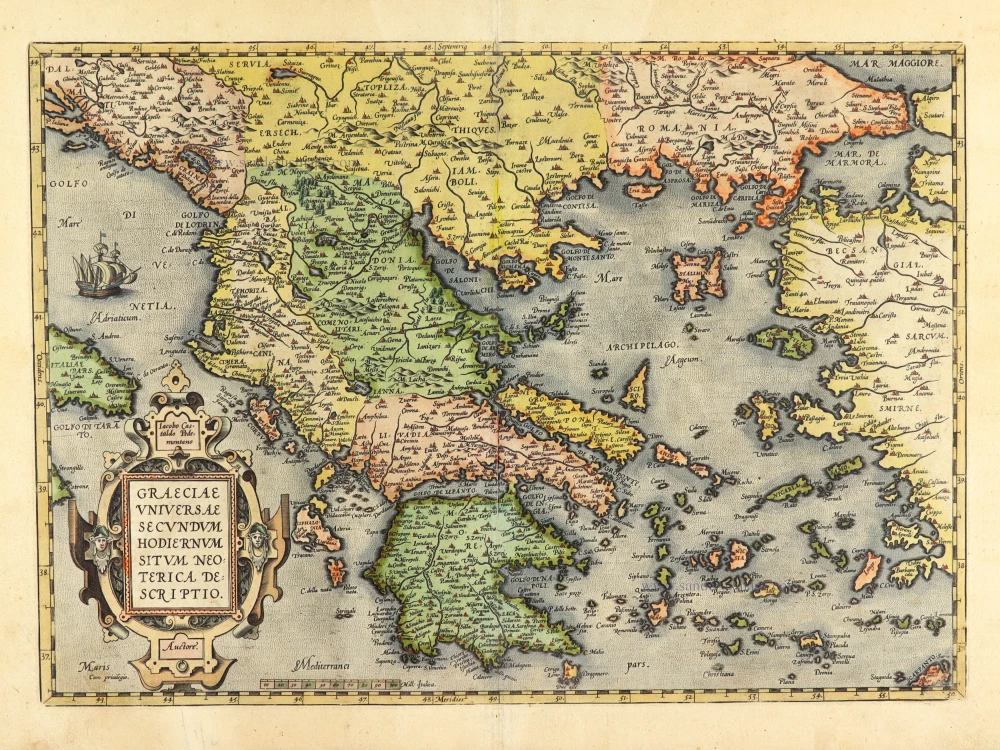Important and rare print.
Battle of Lepanto (Greece), by Giovanni Francesco Camocio. c. 1575
The famous naval battle took place on 7 October 1571 when a fleet of the Holy League, a coalition of Catholic Christian states arranged by Pope Pius V, inflicted a significant defeat on the fleet of the Ottoman Empire in the Gulf of Patras. The victory against the Turkish armies stopped their advance in Europe, protecting Rome from invasion. Lepanto marks the last major sea battle fought between only galleys.
Giovanni Francesco Camocio (active in Venice between 1552 and 1575)
Giovanni Francesco Camocio, Venetian publisher and engraver was born in the first half of the 16th century, probably in Asolo (Treviso). He then moved to Venice, where his publishing activity has been registered since 1552. He was the owner of the bookshop Al segno della Piramide (At the Sign of the Pyramid) in San Lio in Merceria, where his main activity was the sale of prints and engravings, engraved reproductions of works of art and geographical maps. Camocio was one of the most significant publishers of the time. The presence of his name on many papers and prints and his numerous requests for privilege testify to his intense activity. It included subjects derived from great artists such as Titian and Michelangelo, views of cities, fortresses, and geographic maps. To realise these maps, he collaborated with famous engravers and cartographers, including Domenico Zenoi, Paolo Forlani, Giacomo Gastaldi and others. Many small-format papers were published between 1566 and 1574, forming the volume known as Isole famose (famous islands). The drawing of a pyramid on four spheres, resting on a pedestal with the inscription Prudentia perpetuat and a snake's head represents the typographic mark he used. It is assumed that the publisher died around 1575 because there is no more news of his activity after this date, which corresponds with the spread of a severe plague in Venice.
Al Molto Mag.co Sig. Gentile Carbonana da Gubio. Qui rappresento a V.S. brevemente il Successo della mirabile vittoria della armata di la S.ta Lega christiana contra la potentissima et orgogliosa di Sultan Di Vinegia l Anno 1572.
Item Number: 27633 Authenticity Guarantee
Category: Antique maps > Asia > Turkey - Cyprus
Old, antique map of Battle of Lepanto (Greece), by Giovanni Francesco Camocio.
Title: Al Molto Mag.co Sig. Gentile Carbonana da Gubio. Qui rappresento a V.S. brevemente il Successo della mirabile vittoria della armata di la S.ta Lega christiana contra la potentissima et orgogliosa di Sultan Di Vinegia l Anno 1572.
Date of the first edition: 1571.
Date of this map: c. 1575.
Copper engraving, printed on paper.
Size (not including margins): 190 x 250mm (7.48 x 9.84 inches).
Verso: Blank.
Condition: Excellent.
Condition Rating: A+.
References: Bifolco-Ronca, Tav. 817 State 3;; Zacharakis, #806
From: G.F Camocio. Isole Famose, Porti, Fortezze, e Terre Maritime. Venice, Libraria des segno di S. Marco (i.e. D. Bertelli), c. 1575. (Phillips 3975; Bifolco-Ronca, p.140ff)
The famous naval battle took place on 7 October 1571 when a fleet of the Holy League, a coalition of Catholic Christian states arranged by Pope Pius V, inflicted a significant defeat on the fleet of the Ottoman Empire in the Gulf of Patras. The victory against the Turkish armies stopped their advance in Europe, protecting Rome from invasion. Lepanto marks the last major sea battle fought between only galleys.
Giovanni Francesco Camocio (active in Venice between 1552 and 1575)
Giovanni Francesco Camocio, Venetian publisher and engraver was born in the first half of the 16th century, probably in Asolo (Treviso). He then moved to Venice, where his publishing activity has been registered since 1552. He was the owner of the bookshop Al segno della Piramide (At the Sign of the Pyramid) in San Lio in Merceria, where his main activity was the sale of prints and engravings, engraved reproductions of works of art and geographical maps. Camocio was one of the most significant publishers of the time. The presence of his name on many papers and prints and his numerous requests for privilege testify to his intense activity. It included subjects derived from great artists such as Titian and Michelangelo, views of cities, fortresses, and geographic maps. To realise these maps, he collaborated with famous engravers and cartographers, including Domenico Zenoi, Paolo Forlani, Giacomo Gastaldi and others. Many small-format papers were published between 1566 and 1574, forming the volume known as Isole famose (famous islands). The drawing of a pyramid on four spheres, resting on a pedestal with the inscription Prudentia perpetuat and a snake's head represents the typographic mark he used. It is assumed that the publisher died around 1575 because there is no more news of his activity after this date, which corresponds with the spread of a severe plague in Venice.




